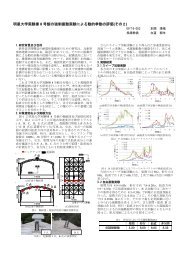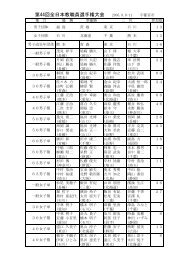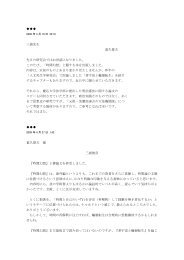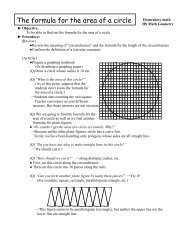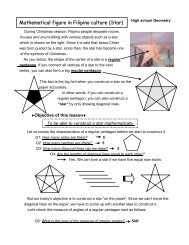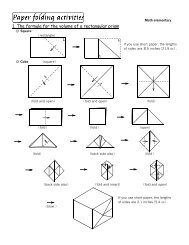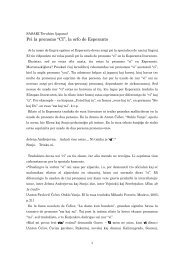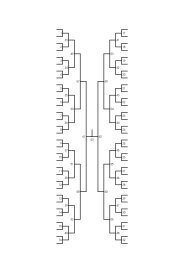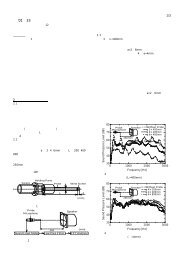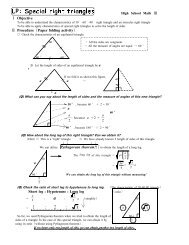How to make a cone for measuring the volume
How to make a cone for measuring the volume
How to make a cone for measuring the volume
Create successful ePaper yourself
Turn your PDF publications into a flip-book with our unique Google optimized e-Paper software.
<strong>How</strong> <strong>to</strong> <strong>make</strong> a <strong>cone</strong> <strong>for</strong> <strong>measuring</strong> <strong>the</strong> <strong>volume</strong><br />
For teachers<br />
In teaching elementary and high school geometry, we derive <strong>the</strong> <strong>for</strong>mula <strong>for</strong> <strong>the</strong> <strong>volume</strong> of<br />
a <strong>cone</strong> by comparing <strong>the</strong> <strong>volume</strong> of a cylinder with a <strong>volume</strong> of a <strong>cone</strong> by using rice or<br />
water. In this <strong>to</strong>pic, teachers are required <strong>to</strong> <strong>make</strong> a <strong>cone</strong> and a cylinder accurately in order<br />
<strong>to</strong> get an exact result. Several ma<strong>the</strong>matical methods of making a <strong>cone</strong> by using a paper<br />
(Board paper) are introduced in this handout. You can <strong>make</strong> a <strong>cone</strong> based on <strong>the</strong> size of a<br />
cylinder accurately!<br />
► Utilizing special right triangles<br />
We have already known <strong>the</strong> following special right triangles that <strong>the</strong> ratio of three lengths of<br />
sides is represented by whole numbers. (You can confirm it by using Pythagorean <strong>the</strong>orem.)<br />
We are going <strong>to</strong> utilize it <strong>to</strong> <strong>make</strong> a <strong>cone</strong>.<br />
5<br />
4<br />
5 2 =4 2 +3 2<br />
25=16+9<br />
13<br />
12<br />
13 2 =12 2 +5 2<br />
169=144+25<br />
3<br />
5 4<br />
3<br />
× 2<br />
10<br />
6<br />
8<br />
5<br />
13<br />
5<br />
12<br />
(Example) we are going <strong>to</strong> <strong>make</strong> this <strong>cone</strong> from a shell<br />
<br />
13<br />
6<br />
5<br />
(Circumference of a base)<br />
= Diameter×circular constant<br />
12×π=12×3.14 =37.68= (arc length of a sec<strong>to</strong>r)<br />
↑Not necessary <strong>to</strong> compute<br />
(The central angle of <strong>the</strong> sec<strong>to</strong>r)<br />
The arc length of <strong>the</strong> sec<strong>to</strong>r =<br />
x<br />
20× π × = 12×π<br />
360<br />
diameter ×π ×<br />
20 × x = 12 x = 18×<br />
12 = 216°<br />
360<br />
( central)<br />
angle<br />
360
There<strong>for</strong>e,<br />
The procedure of making a <strong>cone</strong> is below.<br />
○1 Compute <strong>the</strong> circumference of <strong>the</strong> base<br />
○2 Compute <strong>the</strong> central angle of <strong>the</strong> sec<strong>to</strong>r<br />
○3 Draw a line which length is 10cm<br />
○4 Measure <strong>the</strong> central angle that is 216° or<br />
144°(360°-216°)<br />
○5 Draw a line which length is 10cm<br />
○6 Create an arc with <strong>the</strong> use of a compass<br />
(If you need a base of a <strong>cone</strong>, draw a circle<br />
whose radius is 10cm. Also if you need an over<br />
lapping edge, you can create it.)<br />
○7 Cut <strong>the</strong> sec<strong>to</strong>r and <strong>make</strong> it<br />
(Try exercise)<br />
►General method<br />
If you'd like students <strong>to</strong> use several different <strong>cone</strong>s in <strong>the</strong> activity, you can also <strong>make</strong> any<br />
sizes of <strong>cone</strong>s. (But you might need <strong>to</strong> use a calcula<strong>to</strong>r.)<br />
Cylinder<br />
x<br />
2πx<br />
x<br />
y<br />
y<br />
Slant height<br />
2 2<br />
x + y y<br />
x<br />
2<br />
x +<br />
a<br />
y<br />
2<br />
2<br />
2x π = 2×<br />
π × x + y ×<br />
360<br />
2 a<br />
Circumference of <strong>the</strong> base = arc length of <strong>the</strong> sec<strong>to</strong>r<br />
x<br />
Cone<br />
The central angle (a) =<br />
x × 360<br />
x<br />
2<br />
+ y<br />
2<br />
○1 Compute <strong>the</strong> slant height of a <strong>cone</strong> by using Pythagorean <strong>the</strong>orem<br />
○2 Compute <strong>the</strong> circumference of a base<br />
○3 Computer <strong>the</strong> central angle of <strong>the</strong> sec<strong>to</strong>r<br />
○4 Draw a line which length is equal <strong>to</strong> <strong>the</strong> slant height<br />
○5 Measure <strong>the</strong> central angle of <strong>the</strong> sec<strong>to</strong>r (○2 )<br />
○6 Draw a line which length is equal <strong>to</strong> slant height<br />
○7 Create an arc with <strong>the</strong> use of a compass
► Example<br />
We are going <strong>to</strong> use a wafer stick container as a cylinder.<br />
○1 Measure <strong>the</strong> sizes of this container (approximately).<br />
<br />
4.7 cm<br />
<br />
16 cm<br />
Based on this cylinder, we are going <strong>to</strong> <strong>make</strong> a <strong>cone</strong> whose base and height are<br />
congruent <strong>to</strong> <strong>the</strong> corresponding parts of <strong>the</strong> cylinder respectively.<br />
○2 Compute <strong>the</strong> size of <strong>the</strong> shell of a <strong>cone</strong>.<br />
4.7 cm<br />
16 cm<br />
<br />
2<br />
2<br />
16 + ( 4.7) = 256 + 22. 09<br />
= 278.09<br />
= 16.7(<br />
appoximately)<br />
cm<br />
4.7 cm<br />
<br />
a<br />
2× 4.7 × π = 2×<br />
16.7 ×<br />
360<br />
4.7 cm<br />
16.7 cm<br />
9 .4×<br />
360<br />
a =<br />
33.4<br />
=101° (approximately)<br />
○3 Form a <strong>cone</strong> by using scotch tape<br />
Ateneo De Davao University - Regional Science Teaching Center



